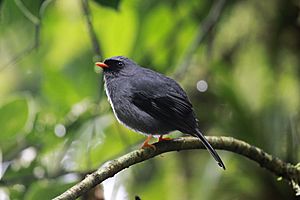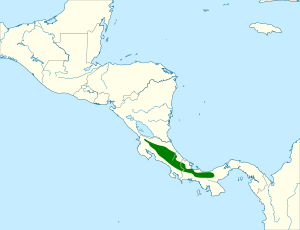Black-faced solitaire facts for kids
Quick facts for kids Black-faced solitaire |
|
|---|---|
 |
|
| Conservation status | |
| Scientific classification | |
| Genus: |
Myadestes
|
| Species: |
melanops
|
 |
|
The black-faced solitaire (Myadestes melanops) is a special kind of bird that lives in the mountains of Costa Rica and western Panama. It belongs to the thrush family, which is known for its beautiful songs.
| Top - 0-9 A B C D E F G H I J K L M N O P Q R S T U V W X Y Z |
Where the Black-faced Solitaire Lives
This bird prefers to live in dense, wet mountain forests. You can usually find it among thick bushes and bamboo plants. It lives at high altitudes, typically from about 750 to 3,000 meters (2,460 to 9,840 feet) above sea level. During the rainy season, it might fly down to lower areas, sometimes as low as 400 meters (1,310 feet).
Building a Nest
Black-faced solitaires are clever nest builders. They create a cup nest using soft materials like mosses and liverworts. They often hide their nests in tree cracks, holes in mossy banks, or tucked away among mosses and other plants growing on tree branches. These nests are usually built up to 3.5 meters (11.5 feet) off the ground.
The female bird lays two or three eggs between April and June. The eggs are white or pinkish with reddish-brown marks. Baby solitaires leave the nest after about 15 to 16 days.
What the Black-faced Solitaire Looks Like
The black-faced solitaire is a slender bird, about 16 to 18.5 centimeters (6.3 to 7.3 inches) long. It weighs around 33 grams (1.2 ounces), which is about the same as a few strawberries.
Adult solitaires are mostly slate gray. They have a striking black face and chin, which stands out against their bright orange beak. Their wings and tail are black with slate-colored edges. When they fly, you might notice the silvery-white feathers under their wings. Their legs are also orange.
Young black-faced solitaires look a bit different. They have light brown streaks on their head and upper body. Their undersides are mottled with patches of light brown and darker brown.
What the Black-faced Solitaire Eats
This bird usually looks for food low down in the plants. It mainly eats berries, but it also enjoys insects. Sometimes, it will fly up into the treetops or even into trees in open fields to find food.
The Solitaire's Song
The black-faced solitaire is famous for its calls and songs. Its call sounds like a nasal ghank or a liquid quirt. But its song is truly special! It's a beautiful, flute-like whistle that sounds like teedleedlee…tleedleeee…lee-dah…lee-dah. These songs are often heard in the evening from a shady spot in the trees.
Because its song is so pure and almost magical in nature, some people who keep these birds in cages have given them a funny nickname: "squeaky hinge bird." This is because the very slow, drawn-out notes can sometimes sound a bit like a rusty door hinge.
Protecting the Black-faced Solitaire
The black-faced solitaire is still common in areas that are protected or hard to reach. However, its numbers have been affected in other places. This is because some people try to catch these birds to sell them as pets, especially because of their amazing song. It's important to protect these beautiful birds so they can continue to thrive in their natural homes.
See also
- In Spanish: Solitario carinegro para niños


